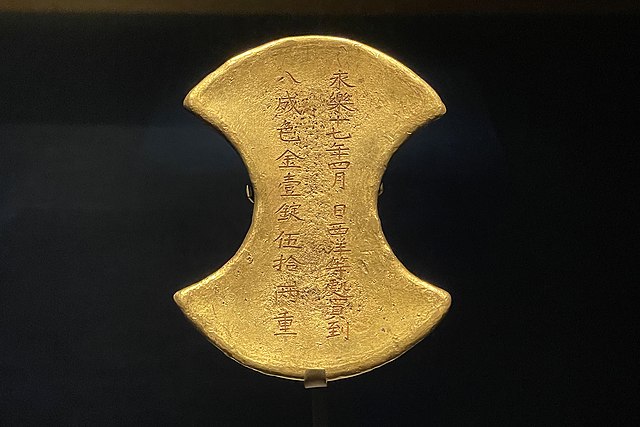The Ming treasure voyages were maritime expeditions undertaken by Ming China's treasure fleet between 1405 and 1433. The Yongle Emperor ordered the construction of the fleet in 1403. The grand project resulted in seven far-reaching ocean voyages to the coastal territories and islands of the South China Sea and Indian Ocean. Admiral Zheng He was commissioned to command the fleet for the expeditions. Six of the voyages occurred during the Yongle Emperor's reign and the seventh voyage occurred during the Xuande Emperor's reign. The first three voyages reached up to Calicut on India's Malabar Coast, while the fourth voyage went as far as Hormuz in the Persian Gulf. In the last three voyages, the fleet traveled up to the Arabian Peninsula and East Africa.
Painting of the Yongle Emperor, dated to the Ming dynasty (National Palace Museum)
Wax statue of Admiral Zheng He (Quanzhou Maritime Museum)
The Chinese treasure fleet as painted by Vladimir Kosov, dated 2018
A gold ingot excavated from the tomb of Prince Zhuang of Liang, a son of the Hongxi Emperor, with an inscription stating that the ingot was made from gold purchased at the Western Ocean in the 17th year of the Yongle reign (1419), indicating that the gold was purchased in the fifth voyage (Hubei Provincial Museum)
The Ming dynasty, officially the Great Ming, was an imperial dynasty of China, ruling from 1368 to 1644 following the collapse of the Mongol-led Yuan dynasty. The Ming dynasty was the last imperial dynasty of China ruled by the Han people, the majority ethnic group in China. Although the primary capital of Beijing fell in 1644 to a rebellion led by Li Zicheng, numerous rump regimes ruled by remnants of the Ming imperial family—collectively called the Southern Ming—survived until 1662.
Portrait of the Hongwu Emperor (r. 1368–98)
The Great Wall of China: Although the rammed earth walls of the ancient Warring States were combined into a unified wall under the Qin and Han dynasties, the vast majority of the brick and stone Great Wall seen today is a product of the Ming dynasty.
A 17th-century Tibetan thangka of Guhyasamaja Akshobhyavajra; the Ming dynasty court gathered various tribute items that were native products of Tibet (such as thangkas), and in return granted gifts to Tibetan tribute-bearers.
Portrait of the Yongle Emperor (r. 1402–24)







